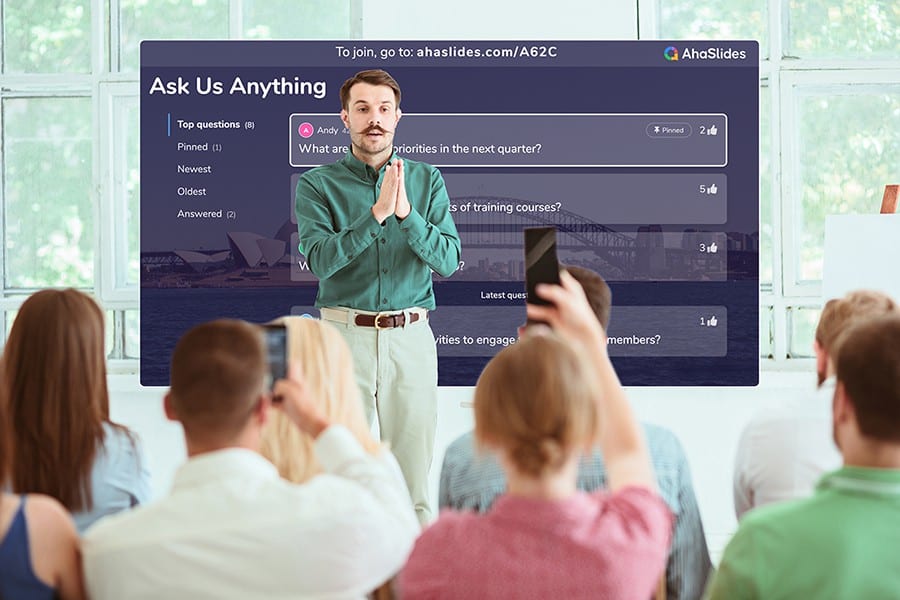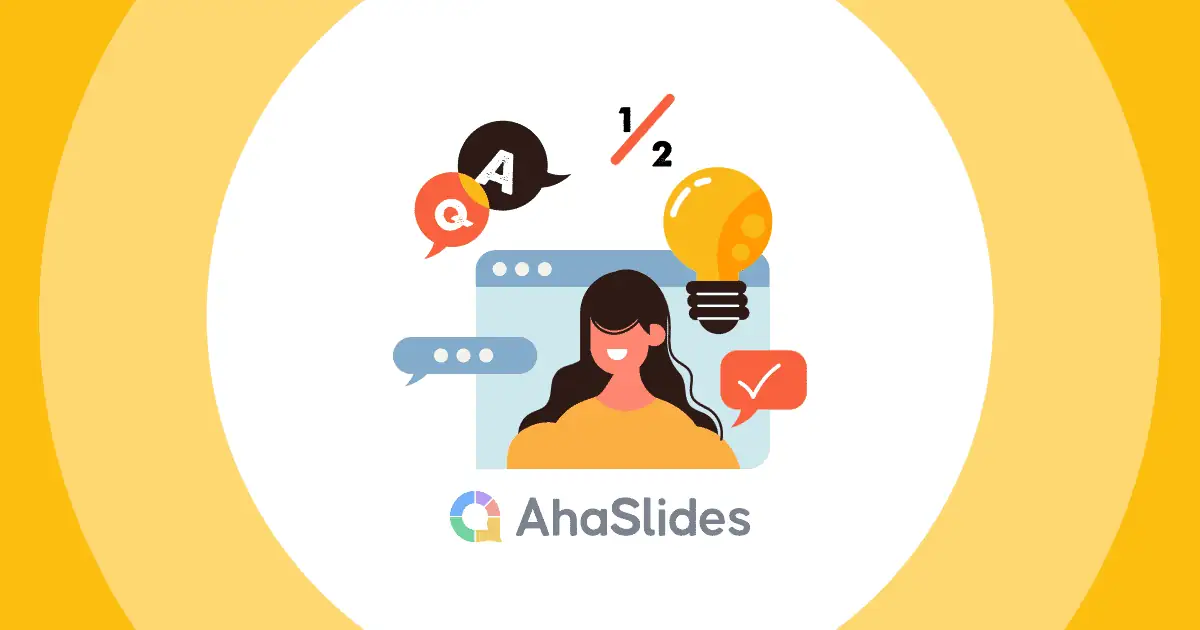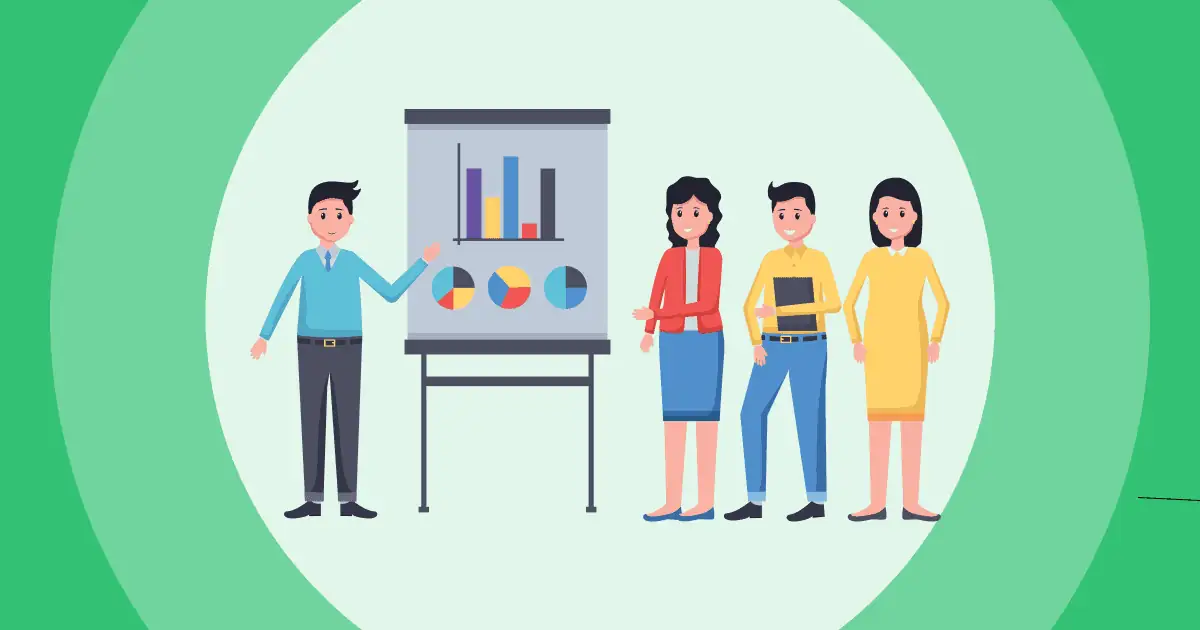Is it difficult to start of presentation? You're standing before a room full of eager listeners, ready to share your knowledge and captivate their attention. But where do you begin? How do you structure your ideas and convey them effectively?
Take a deep breath, and fear not! In this article, we'll provide a road map on how to write a presentation covering everything from crafting a script to creating an engaging introduction.
So, let's dive in!
Table of Contents
- Overview
- What Is A Presentation?
- What Should Be In A Powerful Presentation?
- How To Write A Presentation Script
- How to Write A Presentation Introduction
- Key Takeaways
- FAQs
Tips for Better Presentation

Start in seconds.
Get free templates for your next interactive presentation. Sign up for free and take what you want from the template library!
🚀 Get templates for free
Overview
| How long does it take to make a presentation? | 20 - 60 hours. |
| How can I improve my presentation writing? | Minimize text, optimize visuals, and one idea per slide. |
What Is A Presentation?
Presentations are all about connecting with your audience.
Presenting is a fantastic way to share information, ideas, or arguments with your audience. Think of it as a structured approach to effectively convey your message. And you've got options such as slideshows, speeches, demos, videos, and even multimedia presentations!
The purpose of a presentation can vary depending on the situation and what the presenter wants to achieve.
- In the business world, presentations are commonly used to pitch proposals, share reports, or make sales pitches.
- In educational settings, presentations are a go-to for teaching or delivering engaging lectures.
- For conferences, seminars, and public events—presentations are perfect for dishing out information, inspiring folks, or even persuading the audience.
That sounds brilliant. But, how to write a presentation?

What Should Be In A Powerful Presentation?
How To Write A Presentation? What should be in a powerful presentation? A great presentation encompasses several key elements to captivate your audience and effectively convey your message. Here's what you should consider including in a winning presentation:- Clear and Engaging Introduction: Start your presentation with a bang! Hook your audience's attention right from the beginning by using a captivating story, a surprising fact, a thought-provoking question, or a powerful quote. Clearly state the purpose of your presentation and establish a connection with your listeners.
- Well-Structured Content: Organize your content logically and coherently. Divide your presentation into sections or main points and provide smooth transitions between them. Each section should flow seamlessly into the next, creating a cohesive narrative. Use clear headings and subheadings to guide your audience through the presentation.
- Compelling Visuals: Incorporate visual aids, such as images, graphs, or videos, to enhance your presentation. Make sure your visuals are visually appealing, relevant, and easy to understand. Use a clean and uncluttered design with legible fonts and appropriate color schemes.
- Engaging Delivery: Pay attention to your delivery style and body language. You should maintain eye contact with your audience, use gestures to emphasize key points, and vary your tone of voice to keep the presentation dynamic.
- Clear and Memorable Conclusion: Leave your audience with a lasting impression by providing a strong closing statement, a call to action, or a thought-provoking question. Make sure your conclusion ties back to your introduction and reinforces the core message of your presentation.

How To Write A Presentation Script (With Examples)
To successfully convey your message to your audience, you must carefully craft and organize your presentation script. Here are steps on how to write a presentation script:
1/ Understand Your Purpose and Audience
- Clarify the purpose of your presentation. Are you informing, persuading, or entertaining?
- Identify your target audience and their knowledge level, interests, and expectations.
- Define what presentation format you want to use
2/ Outline the Structure of Your Presentation
Strong Opening
Start with an engaging opening that grabs the audience's attention and introduces your topic. Some types of openings you can use are:
- Start with a Thought-Provoking Question: "Have you ever...?"
- Begin with a Surprising Fact or Statistic: "Did you know that....?"
- Use a Powerful Quote: "As Maya Angelou once said,...."
- Tell a Compelling Story: "Picture this: You're standing at...."
- Start with a Bold Statement: "In the fast-paced digital age...."
Main Points
Clearly state your main points or key ideas that you will discuss throughout the presentation.
- Clearly State the Purpose and Main Points: Example: "In this presentation, we will delve into three key areas. First,... Next,... Finally,.... we'll discuss...."
- Provide Background and Context: Example: "Before we dive into the details, let's understand the basics of....."
- Present Supporting Information and Examples: Example: "To illustrate...., let's look at an example. In,....."
- Address Counterarguments or Potential Concerns: Example: "While..., we must also consider... ."
- Recap Key Points and Transition to the Next Section: Example: "To summarize, we've... Now, let's shift our focus to..."
Remember to organize your content logically and coherently, ensuring smooth transitions between sections.
Ending
You can conclude with a strong closing statement summarizing your main points and leaving a lasting impression. Example: "As we conclude our presentation, it's clear that... By...., we can...."
3/ Craft Clear and Concise Sentences
Once you've outlined your presentation, you need to edit your sentences. Use clear and straightforward language to ensure your message is easily understood.
Alternatively, you can break down complex ideas into simpler concepts and provide clear explanations or examples to aid comprehension.
4/ Use Visual Aids and Supporting Materials
Use supporting materials such as statistics, research findings, or real-life examples to back up your points and make them more compelling.
- Example: "As you can see from this graph,... This demonstrates...."
5/ Include Engagement Techniques
Incorporate interactive elements to engage your audience, such as Q&A sessions, conducting live polls, or encouraging participation. You can also spin more funs into group, by randomly dividing people into different groups to get more diverse feedbacks!
6/ Rehearse and Revise
- Practice delivering your presentation script to familiarize yourself with the content and improve your delivery.
- Revise and edit your script as needed, removing any unnecessary information or repetitions.
7/ Seek Feedback
You can share your script or deliver a practice presentation to a trusted friend, colleague, or mentor to gather feedback on your script and make adjustments accordingly.
More on Script Presentation

How to Write A Presentation Introduction with Examples
How to write presentations that are engaging and visually appealing? Looking for introduction ideas for the presentation? As mentioned earlier, once you have completed your script, it's crucial to focus on editing and refining the most critical element—the opening of your presentation - the section that determines whether you can captivate and retain your audience's attention right from the start.
Here is a guide on how to craft an opening that grabs your audience's attention from the very first minute:
1/ Start with a Hook
To begin, you can choose from five different openings mentioned in the script based on your desired purpose and content. Alternatively, you can opt for the approach that resonates with you the most, and instills your confidence. Remember, the key is to choose a starting point that aligns with your objectives and allows you to deliver your message effectively.
2/ Establish Relevance and Context
Then you should establish the topic of your presentation and explain why it is important or relevant to your audience. Connect the topic to their interests, challenges, or aspirations to create a sense of relevance.
3/ State the Purpose
Clearly articulate the purpose or goal of your presentation. Let the audience know what they can expect to gain or achieve by listening to your presentation.
4/ Preview Your Main Points
Give a brief overview of the main points or sections you will cover in your presentation. It helps the audience understand the structure and flow of your presentation and creates anticipation.
5/ Establish Credibility
Share your expertise or credentials related to the topic to build trust with the audience, such as a brief personal story, relevant experience, or mentioning your professional background.
6/ Engage Emotionally
Connect emotional levels with your audience by appealing to their aspirations, fears, desires, or values. They help create a deeper connection and engagement from the very beginning.
Make sure your introduction is concise and to the point. Avoid unnecessary details or lengthy explanations. Aim for clarity and brevity to maintain the audience's attention.
For example, Topic: Work-life balance
"Good morning, everyone! Can you imagine waking up each day feeling energized and ready to conquer both your personal and professional pursuits? Well, that's exactly what we'll explore today – the wonderful world of work-life balance. In a fast-paced society where work seems to consume every waking hour, it's vital to find that spot where our careers and personal lives harmoniously coexist. Throughout this presentation, we'll dive into practical strategies that help us achieve that coveted balance, boost productivity, and nurture our overall well-being.
But before we dive in, let me share a bit about my journey. As a working professional and a passionate advocate for work-life balance, I have spent years researching and implementing strategies that have transformed my own life. I am excited to share my knowledge and experiences with all of you today, with the hope of inspiring positive change and creating a more fulfilling work-life balance for everyone in this room. So, let's get started!"
🎉 Check out: How to Start a Presentation

Key Takeaways
Whether you're a seasoned speaker or new to the stage, understanding how to write a presentation that conveys your message effectively is a valuable skill. By following the steps in this guide, you can become a captivating presenter and make your mark in every presentation you deliver.
Additionally, AhaSlides can significantly enhance your presentation's impact. With AhaSlides, you can use live polls, quizzes, and word cloud to turn your presentation into an engaging and interactive experience. Let's take a moment to explore our vast template library!
Frequently Asked Questions
How to write a presentation step by step?
You can refer to our step-by-step guide on How To Write A Presentation Script:
Understand Your Purpose and Audience
Outline the Structure of Your Presentation
Craft Clear and Concise Sentences
Use Visual Aids and Supporting Material
Include Engagement Techniques
Rehearse and Revise
Seek Feedback
How do you start a presentation?
You can start with an engaging opening that grabs the audience's attention and introduces your topic. Consider using one of the following approaches:
Start with a Thought-Provoking Question: "Have you ever...?"
Begin with a Surprising Fact or Statistic: "Did you know that....?"
Use a Powerful Quote: "As Maya Angelou once said,...."
Tell a Compelling Story: "Picture this: You're standing at...."
Start with a Bold Statement: "In the fast-paced digital age...."
What are the five parts of a presentation?
When it comes to presentation writing, a typical presentation consists of the following five parts:
Introduction: Capturing the audience's attention, introducing yourself, stating the purpose, and providing an overview.
Main Body: Presenting main points, evidence, examples, and arguments.
Visual Aids: Using visuals to enhance understanding and engage the audience.
Conclusion: Summarizing main points, restating key message, and leaving a memorable takeaway or call to action.
Q&A or Discussion: Optional part for addressing questions and encouraging audience participation.








